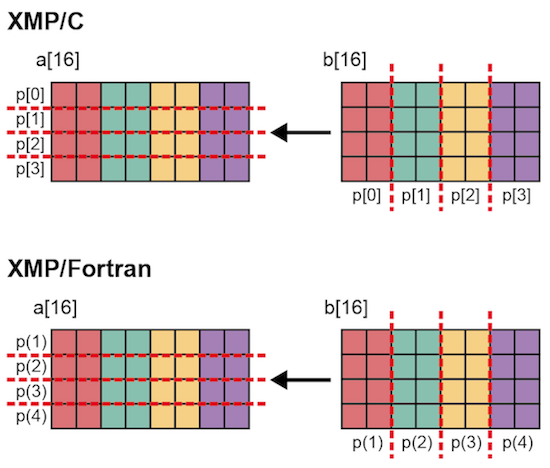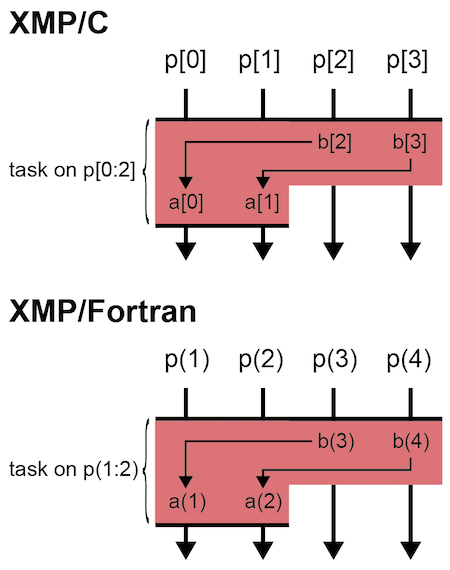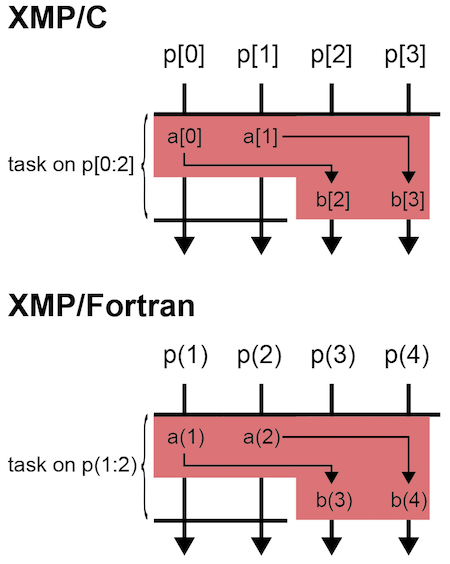14. gmove construct¶
You can describe a communication for distributed arrays in the form of assignment statements by using gmove directive.
There are three modes in gmove; “collective mode”, “in mode,” and “out mode.” While collective mode executes two-sided communication among the executing nodes, in/out modes execute one-sided communication among tasks with a task directive. While in mode uses get communication, out mode uses put communication.
14.1. Collective mode¶
14.1.1. Distributed array¶
Copying a part of array a to array b. Array assignment statements in a gmove construct uses triplet.
- XMP/C program
#pragma xmp nodes p[4]
#pragma xmp template t[16]
#pragma xmp distribute t[block] onto p
int a[16], b[16];
#pragma xmp align a[i] with t[i]
#pragma xmp align b[i] with t[i]
:
#pragma xmp gmove
a[9:5] = b[0:5];
- XMP/Fortran program
!$xmp nodes p(4)
!$xmp template t(16)
!$xmp distribute t(block) onto p
integer :: a(16), b(16)
!$xmp align a(i) with t(i)
!$xmp align b(i) with t(i)
:
!$xmp gmove
a(10:14) = b(1:5)

In XMP/C, p[0] sends b[0] - b[3] to p[2] - p[3], and p[1] sends b[4] to p[3]. Similarly, in XMP/Fortran, p(1) sends b(1) - b(4) to p(3) - p(4), and p(2) sends b(5) to p(4).
In this example, it is assignment statements between distributed arrays with the same shape. XMP also supports to assign it with the different shape.
- XMP/C program
#pragma xmp nodes p[4]
#pragma xmp template t1[16]
#pragma xmp template t2[16]
#pragma xmp distribute t1[cyclic] onto p
#pragma xmp distribute t2[block] onto p
int a[16], b[16];
#pragma xmp align a[i] with t1[i]
#pragma xmp align b[i] with t2[i]
:
#pragma xmp gmove
a[9:5] = b[0:5];
- XMP/Fortran program
!$xmp nodes p(4)
!$xmp template t1(16)
!$xmp template t2(16)
!$xmp distribute t1(cyclic) onto p
!$xmp distribute t2(block) onto p
integer :: a(16), b(16)
!$xmp align a(i) with t1(i)
!$xmp align b(i) with t2(i)
:
!$xmp gmove
a(10:14) = b(1:5)

While array a is distributed in a cyclic manner, array b is distributed in a block manner.
In XMP/C, p[0] sends b[0] and b[4] to p[2] and p[3]. p[1] sends b[1] to p[2]. Each element of p[2] and p[3] will be copied locally. Similarly, in XMP/Fortran, p(1) sends b(1) and b(5) to p(3) and p(4). p(2) sends b(2) to p(3). Each element of p(3) and p(4) will be copied locally.
Note
If the number of elements specified on the right-hand side is other than 1, it will not work properly if the number of elements differs between the right-hand side and the left-hand side.
By using this method, the shape of a distributed array can be changed during calculation.
#pragma xmp nodes p[4]
#pragma xmp template t1[16]
#pragma xmp template t2[16]
int W[4] = {2,4,8,2};
#pragma xmp distribute t1[gblock(W)] onto p
#pragma xmp distribute t2[block] onto p
int a[16], b[16];
#pragma xmp align a[i] with t1[i]
#pragma xmp align b[i] with t2[i]
:
#pragma xmp gmove
a[:] = b[:];
- XMP/Fortran program
!$xmp nodes p(4)
!$xmp template t1(16)
!$xmp template t2(16)
integer :: W(4) = (/2,4,7,3/)
!$xmp distribute t1(gblock(W)) onto p
!$xmp distribute t2(block) onto p
integer :: a(16), b(16)
!$xmp align a(i) with t1(i)
!$xmp align b(i) with t2(i)
:
!$xmp gmove
a(:) = b(:)

In this example, copying all elements of array b which is distributed in a block manner to array a which is distributed in a gblock manner. In arrays a and b, communication occurs only for elements whose responsible nodes do not match (the arrow means communication between nodes in figures).
14.1.2. Scalar¶
In an assignment statement, if one element is specified on the right-hand side and plural elements are specified on the left-hand side, the operation will be broadcast communication.
- XMP/C program
#pragma xmp nodes p[4]
#pragma xmp template t[16]
#pragma xmp distribute t[block] onto p
int a[16], b[16];
#pragma xmp align a[i] with t[i]
#pragma xmp align b[i] with t[i]
:
#pragma xmp gmove
a[9:5] = b[0];
- XMP/Fortran program
!$xmp nodes p(4)
!$xmp template t(16)
!$xmp distribute t(block) onto p
integer :: a(16), b(16)
!$xmp align a(i) with t(i)
!$xmp align b(i) with t(i)
:
!$xmp gmove
a(10:14) = b(1)

In this example, in XMP/C, an element array b[0] of node p[0] will be broadcasted to the specified index of node p[2] and p[3]. Similarly, in XMP/Fortran, an element array b(1) of node p(1) will be broadcasted to the specified index of node p(3) and p(4).
14.1.3. Duplicated array and scalar¶
Not only distributed arrays but also duplicated arrays and scalar variables can be described on the right-hand side.
- XMP/C program
#pragma xmp nodes p[4]
#pragma xmp template t[16]
#pragma xmp distribute t[block] onto p
int a[16], b[16], c;
#pragma xmp align a[i] with t[i]
:
#pragma xmp gmove
a[9:5] = b[0:5];
#pragma xmp gmove
a[9:5] = c;
- XMP/Fortran program
!$xmp nodes p(4)
!$xmp template t(16)
!$xmp distribute t(block) onto p
integer :: a(16), b(16), c
!$xmp align a(i) with t(i)
:
!$xmp gmove
a(10:14) = b(1:5)
!$xmp gmove
a(10:14) = c
In this example, duplicated array and scalar variable are copied to distributed array locally. For this reason, communication does not occur.
14.1.4. Distributed array with different dimension¶
- XMP/C program
#pragma xmp nodes p[4]
#pragma xmp template t1[8]
#pragma xmp template t2[16]
#pragma xmp distribute t1[block] onto p
#pragma xmp distribute t2[block] onto p
int a[8][16], b[8][16];
#pragma xmp align a[i][*] with t1[i]
#pragma xmp align b[*][i] with t2[i]
:
#pragma xmp gmove
a[0][:] = b[0][:];
- XMP/Fortran program
!$xmp nodes p(4)
!$xmp template t1(8)
!$xmp template t2(16)
!$xmp distribute t1(block) onto p
!$xmp distribute t2(block) onto p
integer :: a(16,8), b(8,16)
!$xmp align a(*,i) with t1(i)
!$xmp align b(i,*) with t2(i)
:
#pragma xmp gmove
a(:,1) = b(:,1)

In this example, in XMP/C, b[0][0:2] of p[0], b[0][2:2] of p[1], b[0][4:2] of p[2] and b[0][6:2] of p[3] are copied to a[0][:] of p[0]. Similarly, in XMP/Fortran, b(1:2,1) of p(1), b(3:4,1) of p(2), b(5:6,1) of p(3) and b(7:8,1) of p(4) are copied to a(:,1) of p(1).
14.2. in mode¶
It operates as in mode by setting in clause to gmove directive.
- XMP/C program
#pragma xmp nodes p[4]
#pragma xmp template t[4]
#pragma xmp distribute t[block] onto p
double a[4], b[4];
#pragma xmp align a[i] with t[i]
#pragma xmp align b[i] with t[i]
:
#pragma xmp task on p[0:2]
#pragma xmp gmove in
a[0:2] = b[2:2]
#pragma xmp end task
- XMP/Fortran program
!$xmp nodes p(4)
!$xmp template t(4)
!$xmp distribute t(block) onto p
real :: a(4), b(4)
!$xmp align a(i) with t(i)
!$xmp align b(i) with t(i)
:
!$xmp task on p(1:2)
!$xmp gmove in
a(1:2) = b(3:4)
!$xmp end task
In this example, the task directive divides the node set of 4 nodes into two nodes, the first-half and the second-half. In gmove directive which is in mode, it executes get communication from array of second-half node to array of first-half node.

14.3. out mode¶
It operates as out mode by setting out clause to gmove directive
- XMP/C program
#pragma xmp nodes p[4]
#pragma xmp template t[4]
#pragma xmp distribute t[block] onto p
double a[4], b[4];
#pragma xmp align a[i] with t[i]
#pragma xmp align b[i] with t[i]
:
#pragma xmp task on p[0:2]
#pragma xmp gmove out
b[2:2] = a[0:2]
#pragma xmp end task
- XMP/Fortran program
!$xmp nodes p(4)
!$xmp template t(4)
!$xmp distribute t(block) onto p
real :: a(4), b(4)
!$xmp align a(i) with t(i)
!$xmp align b(i) with t(i)
:
!$xmp task on p(1:2)
!$xmp gmove out
b(3:4) = a(1:2)
!$xmp end task
In this example, it just reversed the assignment statement of the in mode. In gmove directive which is out mode, it executes put communication from array of first-half node to array of second-half node.
